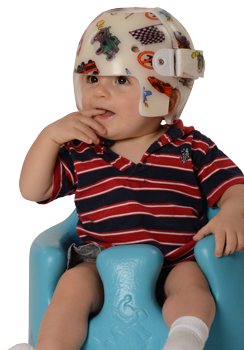Below are frequently asked questions regarding kinderBAND™ and our treatments:
If we haven’t covered your question, comment, or concern here, please contact us here. We’re happy to answer any questions that you have.
Below are frequently asked questions regarding kinderBAND™ and our treatments:
If we haven’t covered your question, comment, or concern here, please contact us here. We’re happy to answer any questions that you have.

The kinderBAND™ is a custom molded cranial remolding orthosis. It is also referred to as a cranial helmet, cranial band and/or orthosis. IIt is cleared by the FDA, as required by all cranial orthoses. The kinderBAND™ is manufactured by BioSculptor.
In 1994, the National Institute of Child Health and Development (NICHD) and its partners, including the American Academy of Pediatrics (AAP) and SIDS Alliance, launched the Back to Sleep campaign. The campaign focused on raising awareness with caregivers that placing infants on their backs to sleep reduced the risk of Sudden Infant Death Syndrome (SIDS). Between1992 and 2001, SIDS rates in the United States declined by over 50 percent. This dramatic decrease has been attributed to more infants being placed to sleep on their backs and is based on national surveys conducted during this ten year period.
The Safe to Sleep campaign is an expansion of the original Back to Sleep campaign—aiming to educate caregivers and health care providers about ways to reduce the risk for Sudden Infant Death Syndrome (SIDS) and other sleep-related causes of infant death. The expanded Safe to Sleep campaign builds on the success and reach of the Back to Sleep campaign. In addition to strategies for reducing the risk of SIDS, Safe to Sleep also describes actions that caregivers can take to reduce the risk of other sleep-related causes of infant death, such as suffocation.
www.nichd.nih.gov/publications/pubs/upload/090458_BTS_general.pdf
Plagiocephaly is a condition where an infant’s head is asymmetrical, having an uneven or irregular shape. Clinically, it is referred to as deformational or positional plagiocephaly. This flattening can occur both prior to birth, during birth and after birth; clinically referred to as prenatal, perinatal and postnatal, respectively. For more information, please visit our Plagiocephaly page.
In fact, the answer is yes. In reviewing the number of cases of plagiocephaly reported between 1999 and 2007 from the Texas Birth Defects Registry, a 9-fold increase was found. Plagiocephaly cases increased from 3.0 cases per 10,000 live births to 28.8, an average increase of 21.2% per year. This is hypothesized to be a result of the Back to Sleep campaign with infants now being put to sleep on their backs and also an increase in preterm births.
Plagiocephaly, as defined above is a condition where an infant’s head is asymmetrical, having an uneven or irregular shape. Brachycephaly and scaphocephaly are specific types of plagiocephaly where there is asymmetrical flattening on the back and sides of the head, respectively. For brachycephaly, this presents as a wider head shape and for scaphocephaly, as a thinner head shape.
Torticollis refers to a twisted or wry neck. Torticollis is caused by the shortening of muscles in the neck, particularly the Sternocleidomastoid (SCM) muscle. It can be congenital (occurring during or shortly after birth) or environmental. When resulting from the placement in utero or the birth process, it is referred to as Congenital Muscular Torticollis (CMS). Environmental causes are a result of remaining in the same position in car seats, swings, etc. and not having the opportunity to turn their neck to both sides. Often, since an infant will favor using their non-affected side of this will lead to plagiocephaly since pressure is always on the same side of the head. For more information, please visit our Torticollis page.
Cranial synostosis is a condition in which an infant’s cranial sutures prematurely close. Sutures are the borders of the bony plates which form an infant’s skull. Normally, the sutures in an infant’s head will close around 2 – 3 years of age. If they close prematurely, the result is cranial synostosis. Cranial synostosis is not treatable with the kinderBAND™. Some of the symptoms may include:
The kinderBAND™ cranial remolding helmet treatment program remolds asymmetrical heads into a more symmetrical shape. Because infants experience rapid growth of the skull between 3 and 18 months, it is possible to remold the head. Symmetrical remolding is achieved by having the kinderBAND™ contact the head on the prominent areas, and creating space in the helmet for growth where the head is asymmetric. As the infant grows, the kinderBAND™ is customized to the developing skull on a 2-3 week interval by removing the interior foam lining. This encourages growth into the concavity formed in the helmet, thus achieving the desired skull and facial symmetry over time.
No, the kinderBAND™ will not affect your baby’s neurological development. However, there have been several studies which point out that infants with plagiocephaly score lower on some neurologic assessments, tend to score lower on developmental surveys and obtain motor milestones later than their peers. This is possibly a result of the incidence of preterm birth with plagiocephaly. For more information, please view the study “Case-Control Study of Neurodevelopment in Deformational Plagiocephaly.”
No. The kinderBAND™ is made of flexible plastic, lined with a soft foam interior. The cranial orthosis should never be tight, in fact, it may seem loose. The infant grows into the concave symmetrical space in the orthosis. Because infant’s heads are so soft, any undesired pressure will manifest as a red mark. If this occurs, the cranial specialist will adjust the orthosis accordingly to ensure a proper fit.
Infants with plagiocephaly may be treated from 3 to 18 months of age. Intervention is most effective, however, when it begins between 3 – 9 months.